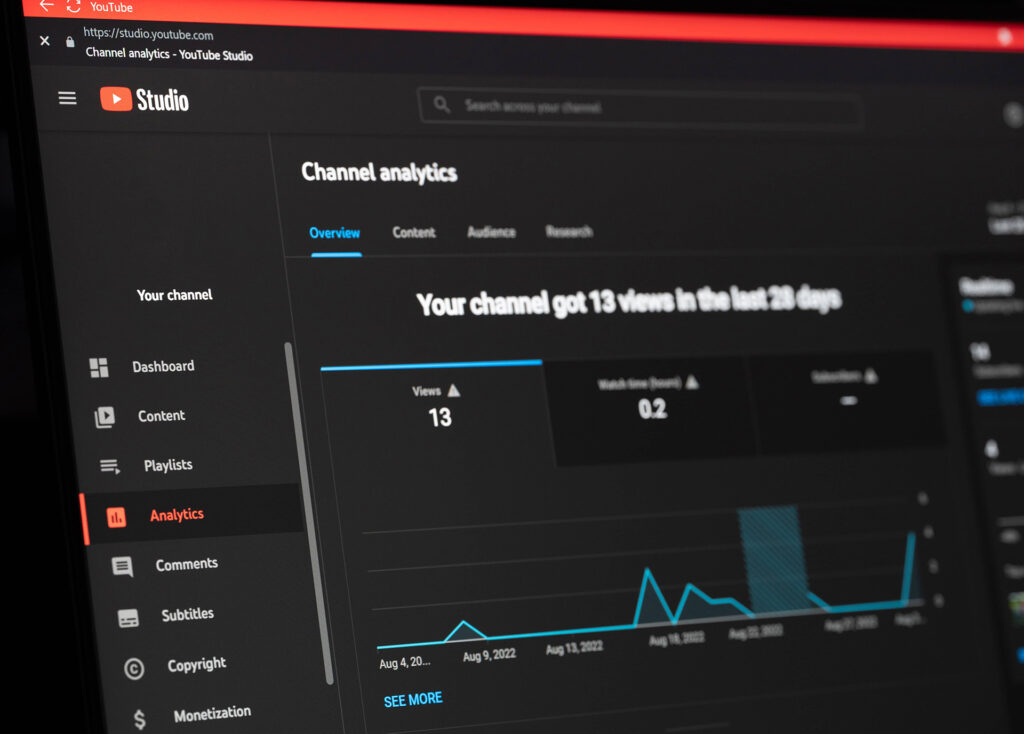The overview tab helps you view channel performance and trends, and it lets you see what is working best for your business.

The overview tab helps you view channel performance and trends, and it lets you see what is working best for your business.
The reach tab provides data about video discovery both from and external to YouTube.
The list above is, by no means, exhaustive. YouTube analytics covers a wide range of topics and information that can help you run a successful YouTube campaign, and they should be considered essential to any sound marketing strategy.
Get in there and start clicking around. Take the time to learn about your audience, what content they enjoy, and what you can improve on to create an even more successful future for your business on this incredibly versatile and important marketing platform.

Deciding to use YouTube to market your business is a great move. Understanding YouTube analytics is a key factor in your success, whether you are trying to monetize your channel or merely use it as an additional part of your marketing strategy.
The great thing is, while it may seem overwhelming at first, YouTube provides a wealth of information to help you more appropriately target your intended audience both on and off the platform, including things like demographic information, traffic sources and times, and even the keywords used to find your video. It also allows you to see how your video preforms based on the title, length, and thumbnails used.
This type of information can be highly valuable for creating content that is relevant, because it can help you refine your strategy and message, to help your business keep growing. What’s better, according to Oberlo, consumers appreciate videos from the brands they engage with. In fact, 54% of consumers want to see more videos from businesses they support.
So if you’ve started on YouTube, you’re likely already helping your business, now let’s talk about how you can make the platform work for you.
The overview tab helps you view channel performance and trends, and it lets you see what is working best for your business.
The reach tab provides data about video discovery both from and external to YouTube.
The list above is, by no means, exhaustive. YouTube analytics covers a wide range of topics and information that can help you run a successful YouTube campaign, and they should be considered essential to any sound marketing strategy.
Get in there and start clicking around. Take the time to learn about your audience, what content they enjoy, and what you can improve on to create an even more successful future for your business on this incredibly versatile and important marketing platform.
The overview tab helps you view channel performance and trends, and it lets you see what is working best for your business.
The reach tab provides data about video discovery both from and external to YouTube.
The list above is, by no means, exhaustive. YouTube analytics covers a wide range of topics and information that can help you run a successful YouTube campaign, and they should be considered essential to any sound marketing strategy.
Get in there and start clicking around. Take the time to learn about your audience, what content they enjoy, and what you can improve on to create an even more successful future for your business on this incredibly versatile and important marketing platform.
Now that you know how to get there and navigate the metrics, let’s dig into the tabs and the most important things you can learn there.
The overview tab helps you view channel performance and trends, and it lets you see what is working best for your business.
The reach tab provides data about video discovery both from and external to YouTube.
The list above is, by no means, exhaustive. YouTube analytics covers a wide range of topics and information that can help you run a successful YouTube campaign, and they should be considered essential to any sound marketing strategy.
Get in there and start clicking around. Take the time to learn about your audience, what content they enjoy, and what you can improve on to create an even more successful future for your business on this incredibly versatile and important marketing platform.

Deciding to use YouTube to market your business is a great move. Understanding YouTube analytics is a key factor in your success, whether you are trying to monetize your channel or merely use it as an additional part of your marketing strategy.
The great thing is, while it may seem overwhelming at first, YouTube provides a wealth of information to help you more appropriately target your intended audience both on and off the platform, including things like demographic information, traffic sources and times, and even the keywords used to find your video. It also allows you to see how your video preforms based on the title, length, and thumbnails used.
This type of information can be highly valuable for creating content that is relevant, because it can help you refine your strategy and message, to help your business keep growing. What’s better, according to Oberlo, consumers appreciate videos from the brands they engage with. In fact, 54% of consumers want to see more videos from businesses they support.
So if you’ve started on YouTube, you’re likely already helping your business, now let’s talk about how you can make the platform work for you.
The overview tab helps you view channel performance and trends, and it lets you see what is working best for your business.
The reach tab provides data about video discovery both from and external to YouTube.
The list above is, by no means, exhaustive. YouTube analytics covers a wide range of topics and information that can help you run a successful YouTube campaign, and they should be considered essential to any sound marketing strategy.
Get in there and start clicking around. Take the time to learn about your audience, what content they enjoy, and what you can improve on to create an even more successful future for your business on this incredibly versatile and important marketing platform.
The overview tab helps you view channel performance and trends, and it lets you see what is working best for your business.
The reach tab provides data about video discovery both from and external to YouTube.
The list above is, by no means, exhaustive. YouTube analytics covers a wide range of topics and information that can help you run a successful YouTube campaign, and they should be considered essential to any sound marketing strategy.
Get in there and start clicking around. Take the time to learn about your audience, what content they enjoy, and what you can improve on to create an even more successful future for your business on this incredibly versatile and important marketing platform.
Now that you know how to get there and navigate the metrics, let’s dig into the tabs and the most important things you can learn there.
The overview tab helps you view channel performance and trends, and it lets you see what is working best for your business.
The reach tab provides data about video discovery both from and external to YouTube.
The list above is, by no means, exhaustive. YouTube analytics covers a wide range of topics and information that can help you run a successful YouTube campaign, and they should be considered essential to any sound marketing strategy.
Get in there and start clicking around. Take the time to learn about your audience, what content they enjoy, and what you can improve on to create an even more successful future for your business on this incredibly versatile and important marketing platform.

Have you ever been asked to do something you don’t like or don’t feel like doing? Creating social media videos could look easy to do.

Because business is always changing, it’s no longer a nice-to-have, it’s a strategic imperative to build a workforce that thrives on constant learning and growth.

Why video marketing? It is not a secret that if we were to look at the data on how much time we spend looking at
Innova Leaf Creative Solutions, LLC is a full-service video production and professional animation company based in Gainesville, Florida, specializing in video content for corporate clients and various industry brands across the United States.